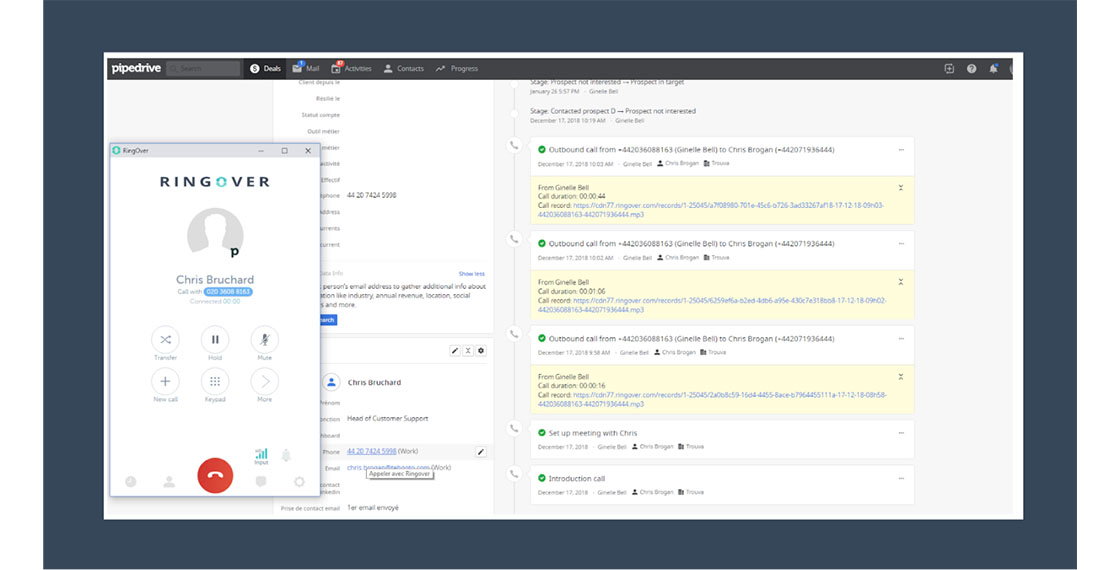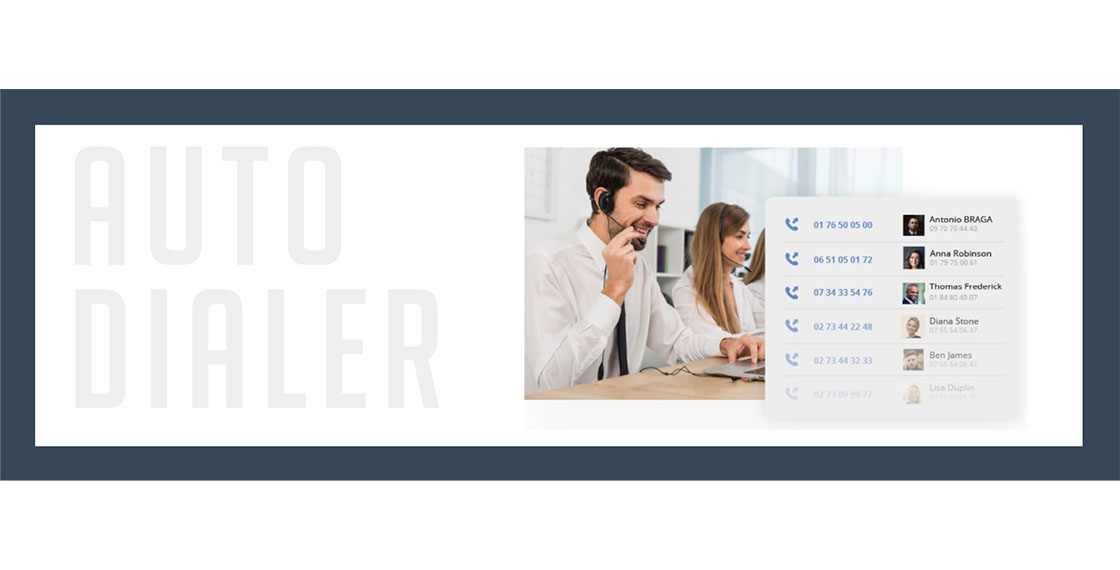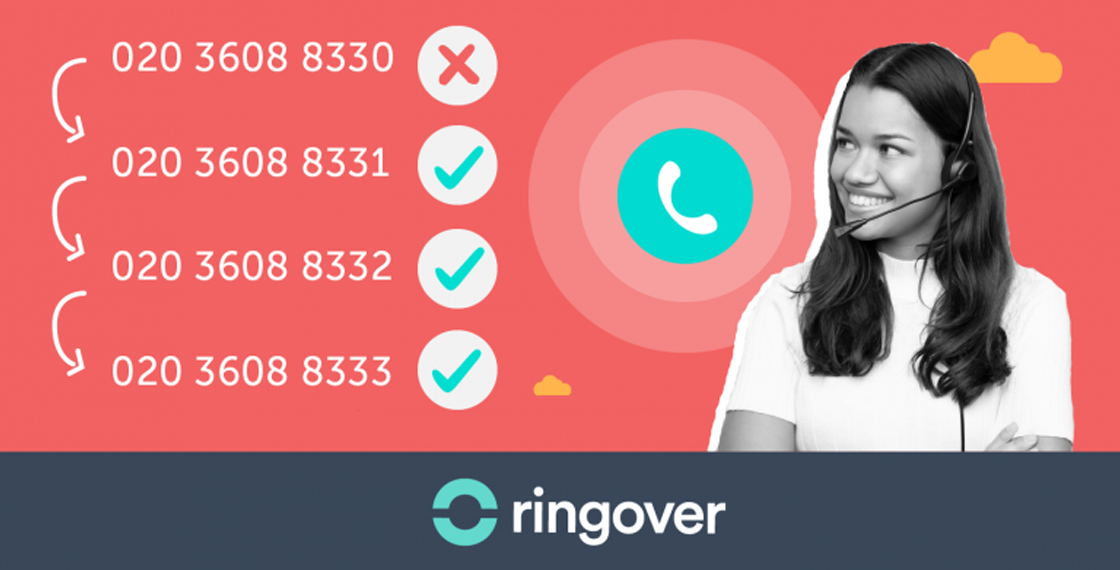Summary
- Making the right choice for my call center automation software
- What are automatic dialers and what is their purpose?
- Video: What is an auto dialer and how can you use it?
- The auto-dialer: the basic version of automated calls
- The smart auto-dialer/intuitive call automation
- The most advanced technologies: Power Dialer and Predictive Dialer – what’s the difference?
- Want to learn more about automated dialers?
Making the right choice for my call center automation software
When choosing informational systems for your call center automation software, there are a multitude of criteria to consider on the solutions side.
CRM Integration

Integrating your telecom to your CRM is essential to increase productivity and ensure good follow-up with clients and prospects. It notably allows:
- Direct call logging in your CRM or client relations software; in other words, all calls made to a prospect are automatically logged in their contact file without an agent needing to manually make note of communication history.
- Automatic file retrieval through your devices: agents can easily access CRM information for calls in progress.
Call distribution
Call automation software offers differing levels of advancement for call distribution systems. For example, it is possible to distribute calls to certain agents according to their skillset, language, history with the correspondent, etc.
Training and supervision features
The right call center software will permit you to better train and supervise your agents through multiple features:
- Call recording: all calls are recorded in the database and are accessible for listening. This allows new recruits to be trained by hearing their calls again so that they can point out mistakes or areas for improvement. In the same way, they can listen to the conversations of experienced agents and make note of their example.
- Double-listening: also used to train newcomers, allows a supervisor to listen in on a live agent’s call and assess their performance or give them feedback after the call.Whispering: when an agent is on a call, it is possible for a supervisor to speak to them without their correspondent being able to hear. This is an extremely practical feature to guide new agents during their first few calls or to assist them during challenging calls.
Productivity features
As with supervision, the right call center software should save you time and allow you to make more calls with:After-Call Work (ACW): once a call is complete, an agent must perform manual tasks for activity follow-up (reports, notes, etc.). During this time, they are not on the line with a correspondent, nor are they available to take any calls. The After-Call Work feature puts aside time for the agent to complete these manual tasks without being disturbed by incoming calls.
Call statistics
Continuous analysis of agent performance is crucial for the proper functioning of a call center. Most call center software offers some performance indicators, but often not enough. It is essential to ensure that you have access to advanced statistics to run your call center with precision. Here is a quick overview of the essential indicators to track:
- Number of calls per agent with details on calls made, calls answered, voicemail, etc.
- Call duration by agent
- Average waiting time for agents per call
- Details on the above indicators between incoming and outgoing calls
- Average communication duration (ACD) in and out
- Service level
- Visual graphics on various performance indicators
What are automatic dialers and what is their purpose?
Definitions and uses
Automated calling software allows phone numbers to be dialed automatically. In general, once communication with a correspondent is established, the software emits an automatic message to make contact with a live agent. This type of call center software is generally used by telemarketing companies or for making sales by phone, or by companies engaging in phone prospecting, saving time for agents who make a large number of calls throughout the day.
Call automation is not only used for reaching a live agent or correspondent. In some cases, a call recipient will hear an automatic or pre-recorded message via an IVR (Interactive Voice Response) server, which will ask them to respond to questions by pressing keys on their phone.
We also find this type of use among organisations performing surveys. In essence, automated calls allow the implementation of technically advanced survey techniques. They are used by large institutions such as Ipsos MORI in the UK; for example, carrying out phone surveys on the general population at random.
The history of automated calls
Historically, the first semi-automatic calling systems (which required human operation) appeared in 1942 in the telecommunications market, offering the possibility of automating call campaigns of up to 12 then 52 numbers.

With today’s developments and the computing power of most recent systems, automatic calling software allows a high volume of simultaneous calls to be made (hundreds or even thousands of phone numbers). It also includes features which make interactions more human and more direct while optimising agent time and performance.There are different types of call mechanisms that use less advanced technology with various applications. Auto Dialer, Power Dialer, Smart Dialer, Predictive Dialer...what’s the difference? In this article, we’ll provide a complete and detailed overview of the most popular systems and their uses.
Video: What is an auto dialer and how can you use it?
The auto-dialer: the basic version of automated calls
What is an auto-dialer?
The auto-dialer (or automatic dialer) is the basic version of automated calls. The system simply calls a predetermined list of numbers in order, emitting a message to put a correspondent in touch with an agent.

2 technologies: modem or phone line
Today the vast majority of auto-dialers work through IP, or via the internet. This is the simplest solution, which is also the easiest to put in place and the least expensive. It is still possible to implement an auto-dialer without passing through the internet using a “telephony board” (a piece of hardware allowing a computer to be connected to a landline phone post). An auto-dialer system can also be installed directly on a phone line. Systems that implement telephony boards directly through phone lines involve the most robust infrastructure and can handle a large volume of calls for a large call center automation compared to a simple computer-based system.However, with the power of today’s computers - especially with multiprocessors and multi-core systems - automatic dialers using VoIP can reach the same performance levels. This is the type of system used in most modern call centers. One final advantage is that it facilitates remote call transfer since it doesn’t rely on physical phone lines.
The smart auto-dialer/intuitive call automation
What is a smart auto-dialer or intelligent call automation?
A smart auto-dialer is an evolved auto-dialer which makes it possible to interpret voice menu responses transmitted via a phone keypad (“press 1, press 2”) or analyse a correspondent’s speech to deliver personalised messages.
How does the smart auto-dialer work?
A smart auto-dialer adds a component to the classic auto-dialer for speech and text analysis. This allows you to translate text into speech, and vice-versa. It is this system that allows the interpretation of a correspondent's responses.Then there are response systems that generally use the same logic: dynamic messages are recorded by a machine that places the right variables into the delivered message to match the request or context of the call.It is possible to personalise smart auto-dialer features depending on the correspondent, CRM data, responses, or call context (hours, date, etc.)
The most advanced technologies: Power Dialer and Predictive Dialer – what’s the difference?
The Power Dialer, for making calls in sequence
The Power Dialer is designed to automate call campaigns.One of the key features of advanced call automation technology is the capacity to determine if a call is picked up by a human or voicemail. This is essential for assuring that agents systematically reach a live person and not their voicemail. It is on this principle that the Power Dialer functions. A pre-set list of numbers is automatically called in order: a number is dialed, and once this action is complete with the call being transferred or going unanswered, the next number is dialed, and so on. Each call is made only once the one before it has completed,this allows agents to systematically reach live people.
The Predictive Dialer for simultaneous calls
Predictive dialing represents the most advanced call automation technology on the market. Instead of dialing numbers in order, it automatically dials multiple numbers at once while analysing call progress to put recipients in contact with agents. To ensure the proper function of such a system, how many numbers will be called simultaneously is continuously determined by a predictive statistical model based on several criteria (number of operational agents, response rate, average time before pick-up, etc.) The algorithm ensures that agents always have a call to handle and that correspondents who answer are immediately put in touch with an available agent.Numerous studies have demonstrated the advantages of this technology. By calling numbers in a sequence with the Power Dialer model, it is estimated that an agent spends 40 minutes per hour - or two-thirds of their time – in communication. Predictive dialing increases this estimate to 57 minutes per hour.
Want to learn more about automated dialers?
Contact our VoIP experts to help guide you step-by-step at +44 20 7509 6665 or send an email to sales@ringover.com. Start your free trial today.
Published on January 31, 2020.

